Silage Additives Frequently Asked Questions
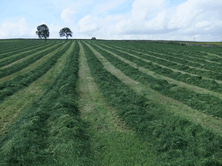 Silage additives have been widely used in the UK for well over 50 years yet there is still a widespread
lack of understanding amongst farmers, contractors, advisors and suppliers, of their mode of action,
how they work, their limitations, benefits of use and which products are most appropriate for a particular
situation. This is hardly surprising since silage making is an extremely complex process with many variables
and with many opportunities for things to go wrong.
Silage additives have been widely used in the UK for well over 50 years yet there is still a widespread
lack of understanding amongst farmers, contractors, advisors and suppliers, of their mode of action,
how they work, their limitations, benefits of use and which products are most appropriate for a particular
situation. This is hardly surprising since silage making is an extremely complex process with many variables
and with many opportunities for things to go wrong.
The Importance of Quality Silage: Our aim at RWN is to work towards improving the quality of UK silages with a view to increasing animal output and milk yields without the need to spend a fortune on additional concentrates.
Better silages produce more milk, are better for cow health, reduce input costs, and result in more profit for the farmer. Better grass, maize or wholecrop silages do not cost significantly more to make than poor silages, but they do require more attention to detail.
Selecting the most effective silage additive for the job is one of many important factors which affect the quality of the silage made
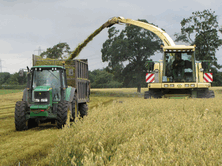 The Ultra-Sile
Range of Biological Silage Additives is in our view the most technically advanced, most
versatile and comprehensive range of forage additives available to farmers in the UK. The range includes
products offering extremely reliable results over a wide range of conditions.
The Ultra-Sile
Range of Biological Silage Additives is in our view the most technically advanced, most
versatile and comprehensive range of forage additives available to farmers in the UK. The range includes
products offering extremely reliable results over a wide range of conditions.
Attention to detail and the use of a quality silage additive appropriate to the situation will go a long way towards producing very high quality and valuable feed with greatly reduced losses most of the time.
Our aim at RWN is to increase the quality of UK silages with a view
to increase
milk yields without the need to spend a fortune on additional concentrates
This FAQ's page attempts to offer at least some clarity to both making consistently better silages and selecting the most appropriate silage additive for your situation.
Better silages produce more milk, are better for cows and produce more profit
Frequently Asked Questions
Inoculants and Silage Making
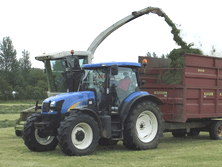 What are the benefits of using a silage additive?
What are the benefits of using a silage additive?- How do silage additives work?
- How can I justify the cost of a silage additive?
- Silage additives are just insurance against bad weather?
- Why use a silage additive when the sun is shining?
- Do I need a silage additive on grass silage above 30% DM?
- By not using a silage additive I am saving money?
- How much money will I save by using a silage additive?
- Why should I use a silage additive on forage maize?
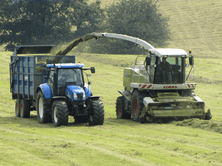 Is there any point using an additive on youngstock silages?
Is there any point using an additive on youngstock silages?- Should I use a silage additive on big bale silage?
- My silage heats on the face. Is it the fault of the additive?
- My current additive has more trial work than other additives?
- My silage keeps running effluent. Is this due to the additive?
- Acid was always the best silage additive?
- Will a preservative do a better job than an inoculant?
- Aren't all biological silage additives pretty much the same?
- The silage additive I use is brewed on the farm to save money?
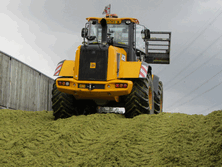 How can I reduce spoilage and dry matter losses?
How can I reduce spoilage and dry matter losses?- How can I improve the ME and crude protein of my silages?
- Why hasn't the silage additive worked?
- My silages are low in energy. Would a different additive help?
- Are there better silage additives out there?
- Will an inoculant work in very wet and dirty conditions?
- What is the best silage additive to prevent silage going butyric?
- My high lactic acid, low pH silage is causing acidosis?
- Why use anything other than Lactobacillus plantarum?
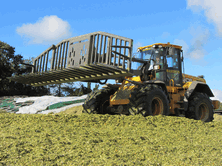 Are multi-strain inoculants better than single strain products?
Are multi-strain inoculants better than single strain products?- How important are the number of bacteria applied?
Ultra-Sile Silage Additives
- Are Ultra-Sile silage additives new?
- Why haven't I heard about Ultra-Sile silage additives before?
- How was the Ultra-Sile Range developed?
- My current supplier says that Ultra-Sile has not been tested?
- Do Ultra-Sile Additives have any trial work?
- Are Ultra-Sile silage additives fully approved and registered?
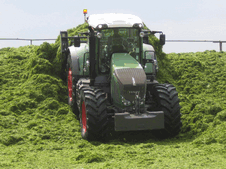 Why are Ultra-Sile silage additives better?
Why are Ultra-Sile silage additives better?- Why are there so many products in the Ultra-Sile Range?
- Can I use one silage additive to treat all my crops?
- How many bacteria do Ultra-Sile inoculants apply?
- Do Ultra-Sile additives apply 1 million Lactobacillus plantarum?
- Will Ultra-Sile improve face stability and prevent heating?
- Will Ultra-Sile silage additives prevent top and shoulder waste?
- Will Ultra-Sile silage additives cope with wet, low sugar grass?
- Do I need to mix Ultra-Sile silage additives the day before?
- What is the application rate for Ultra-Sile silage additive?
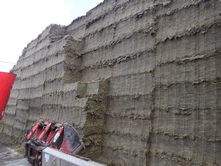 How long will Ultra-Sile silage additives last once mixed?
How long will Ultra-Sile silage additives last once mixed?- My contractor prefers Ultra Low Volume ULV additives?
- Do Ultra-Sile additives come in ULV and Granular options?
- Will Ultra-Sile silage additives help us reach net zero carbon emissions?
- Are Ultra-Sile silage additives suitable for organic use?
- How quickly can Ultra-Sile silage additives be delivered?
- Should I take advantage of early order?
- How do I place an order?
INOCULANTS AND SILAGE MAKING
1. What are the benefits of using silage additive?
The benefits of using an inoculant based silage additive across a wide range of fermented forages is well documented and supported by hundreds of trials both in the UK and overseas.
Using an inoculant speeds up and improves the efficiency of the fermentation process. The result is a more palatable silage with improved stability and which has a feed value closer to that of the crop at harvest, which has lost less feed value and dry matter in the process and is capable of supporting higher levels of animal performance.
Typically inoculants will reduce dry matter losses in storage by up to 4.5% in grass silage equivalent to an additional 45 tonnes of silage at feed out for every 1000 tonnes treated.
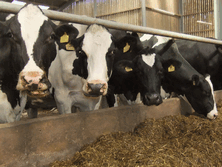 Digestibility and
energy levels are generally higher, protein degradation is cut by about half, and intake characteristics
are improved.
Digestibility and
energy levels are generally higher, protein degradation is cut by about half, and intake characteristics
are improved.
The improvements to silage as a result of using a silage additive have never been easy to measure by silage analysis especially with regard to intake potential and animal performance. But with experience smell and taste reveal that the differences are easily apparent. Cows can certainly tell the difference.
One of the main benefits of treating silage with additive is financial
From the farmers point of view one of the main benefits of using a silage additive is financial. There is more better quality silage to feed as a result of using a silage additive, animals perform better and purchased concentrate costs can be reduced.
Typically yield responses over large numbers of research trials have averaged up to 1.5 litres of milk per cow per day. Live weight gain on heifers and beef stock have been shown to increase by as much as 30% when fed additive treated grass silage.
On average you might expect a 10 : 1 return on the cost of treatment
It is difficult to understand why the use of silage additives in the UK is still not universal. Back to top
2. How do silage additives work?
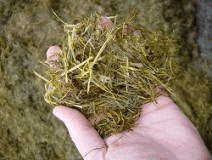 "Silage
is the product formed when grass or any other material of sufficiently high moisture content (and thereby
liable to spoilage by microbes which thrive in air) is stored in the absence of air" .
This definition was coined by Whittenbury (1968). Normally bacteria ferment sugars, producing lactic
and acetic acids and other non-acid products. This results in an increase in acidity and drop in pH which
prevents the growth of clostridia, which would otherwise thrive and produce butyric acid and other
noxious substances, and which also prevents the growth of yeasts and fungi.
"Silage
is the product formed when grass or any other material of sufficiently high moisture content (and thereby
liable to spoilage by microbes which thrive in air) is stored in the absence of air" .
This definition was coined by Whittenbury (1968). Normally bacteria ferment sugars, producing lactic
and acetic acids and other non-acid products. This results in an increase in acidity and drop in pH which
prevents the growth of clostridia, which would otherwise thrive and produce butyric acid and other
noxious substances, and which also prevents the growth of yeasts and fungi.
The concept of inoculating silages with elite strains of bacteria in order to control and carry out an efficient, rapid, cool fermentation with minimum loss of energy, protein and other nutrients, as opposed to natural fermentation conducted by whatever microbes happened to be present on the day, is now widely accepted throughout the World.Back to top
3. How can I justify the cost of a silage additive?
Silage additives were a good economic proposition in the early 1980's. Since then the economics of using additives on silage have improved markedly. Over the past 40 years milk prices as well as the cost of forage and concentrates have more than doubled whilst silage additives have improved in quality and reduced in price by around 30%. There is now no economic justification for not using an additive on any fermented forage crop at today's prices.
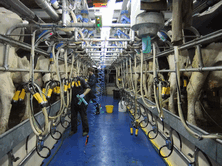 A
review of 256 additive trials (Jones R, IGER 2005) showed that bacterial inoculant
treated silages had higher DM digestibility and reduced levels of protein degradation. The average response
in milk production trials was over 1.5 litres of milk /cow/day.
A
review of 256 additive trials (Jones R, IGER 2005) showed that bacterial inoculant
treated silages had higher DM digestibility and reduced levels of protein degradation. The average response
in milk production trials was over 1.5 litres of milk /cow/day.
With milk prices at around 45 pence per litre this would represent over £0.65 /cow/day at today's prices whilst the cost of treating the silage is equivalent to 3 - 5 pence /cow/day. Trials have also shown benefits in terms of milk quality, body condition, fertility etc.
On average trial results have shown a reduction in fermentation and storage losses on treated grass silage of up to 4.5%. A saving of 45 tonnes of silage worth say £45 / tonne on every 1000 tonnes treated is worth £1800 compared with a treatment cost of £900 - £1250.
Silage additives can also reduce heating at the face and aerobic losses during feed out. It has been estimated that for every 1oC rise in clamp temperature above ambient, 0.23% DM is lost each day.
Research has demonstrated typically 10 : 1 return on the cost of treatment
Combining savings in dry matter with animal performance benefits results in a typical return on investment of 10 : 1 and could represent an increase in margin per cow of £100 over a winter. Back to top
4. Silage Additives are just insurance against bad weather?
It is true that in the early days of silage making acids were used as an 'insurance' in bad weather to prevent wet grass silages from turning butyric. Today biological inoculants have replaced chemical acid additives almost exclusively and for good reason. Inoculation takes control of the fermentation using highly efficient elite strains of bacteria to carry out the fermentation rather than allowing an inefficient and unreliable fermentation to result from whatever microbes happened to be present on the crop on the day and which would have included a host of spoilage organisms.
The use of modern additives has little to do with the weather
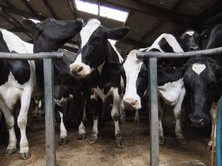 Hundreds
of trials have proven that animal performance is improved when silage is treated with an inoculant based
silage additive, whether or not the weather is good or bad. This is due to more efficient use of sugars
to produce acids. Sugars are used around twice as efficiently with a silage additive. About half as much
protein is degraded. Much less heat is produced over a much shorter time. So much less energy wasted.
Fewer spoilage organisms are present. Silage is more palatable and has improved intake characteristics.
Hundreds
of trials have proven that animal performance is improved when silage is treated with an inoculant based
silage additive, whether or not the weather is good or bad. This is due to more efficient use of sugars
to produce acids. Sugars are used around twice as efficiently with a silage additive. About half as much
protein is degraded. Much less heat is produced over a much shorter time. So much less energy wasted.
Fewer spoilage organisms are present. Silage is more palatable and has improved intake characteristics.
All fermented forages should be treated with silage additive even in good weather
These benefits are nothing to do with bad weather. They are about taking control of the fermentation and preventing less effective micro-organisms, spoilage organisms, moulds and yeasts from wasting valuable nutrients and spoiling the clamp. Back to top
5. Why use a silage additive when the sun is shining?
The myth that "sunshine is the best silage additive" stems from the early days of using acid additives to prevent wet high nitrogen grass silages from going butyric. This misunderstanding of how biological inoculant based additives work has cost the industry many millions of pounds over the years.
Inoculants give a rapid and efficient fermentation completing in days rather than in weeks when not treated. The clamp remains relatively cool with energy and dry matter losses much lower than with un-treated silage. Much less protein is degraded and more of the protein is in a form that cattle can use for production. These benefits apply irrespective of ensiling conditions or grass dry matter.
The benefits of treating all forages with silage additive in all conditions
even when the sun is shining are well proven
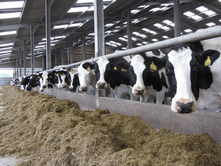 The
benefits of treating all silages even in good, sunny conditions have been illustrated by 11 dairy trials
at Hillsborough where treated grass silages cut in good conditions increased milk yields by 1.3 litres
per cow compared with untreated control silages.
The
benefits of treating all silages even in good, sunny conditions have been illustrated by 11 dairy trials
at Hillsborough where treated grass silages cut in good conditions increased milk yields by 1.3 litres
per cow compared with untreated control silages.
Similarly a trial at IGER in good conditions increased live weight gain on beef animals from 0.8 to 1.1 kgs per day compared with untreated silage an increase of 37%.
In practice it is cheaper to treat forages when conditions are good, since the application rates of most silage additives are per tonne of fresh weight forage. This means that only half the silage additive would be needed per acre to treat silage at 36% DM compared with silage at 18% DM. Contrary to popular belief treating silage with an additive in good dry conditions may give an even better return than treating silage in wet conditions.
Silage additive treatment in dry conditions may give an even better return
than when used in wet conditions
The logic for applying silage additive at a lower rate in dry conditions is that there are generally more sugars, and less acid is needed to preserve the silage since there is less water present and often there is less soil contamination. There is less risk of going butyric, the fermentation is easier and fewer inoculant bacteria are needed in order to dominate the fermentation. Back to top
6. Do I need a silage additive on dry silages above 30% dry matter?
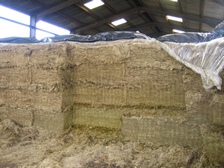 Untreated,
drier grass silages will not go butyric but will still take up to 6 weeks to ferment. They tend to heat
to higher temperatures for longer, lose more energy, lose dry matter, have typically double the protein
broken down and be less palatable than additive treated silage.
Untreated,
drier grass silages will not go butyric but will still take up to 6 weeks to ferment. They tend to heat
to higher temperatures for longer, lose more energy, lose dry matter, have typically double the protein
broken down and be less palatable than additive treated silage.
Untreated silages are also likely to produce reduced levels of animal performance and to have an increased risk of mycotoxin contamination and aerobic instability with heating at the face. All dependent of course on the type of silage additive used.
We would not recommend the use of a lactic only product on silage above 30% DM which may actually increase the risk of heating due to the reduced levels of volatile fatty acids produced by a homo-lactic fermentation. Use an inoculant, based on hetero-fermentative strains of bacteria, which are capable of producing more volatile fatty acids including acetic acid and propionic acid, in order to reduce the risk of heating at the silage face.
Typically silage additives can yield a return on investment
of 10 : 1 even in good weather
A great deal of trial work has been carried out looking at the silage additive treatment of drier silages and it is quite clear that use of an inoculant will generally give a much more efficient fermentation, with reduced dry matter losses and improved animal performance.
Less silage additive is used on dry silages since recommended application rates are per tonne of fresh weight forage and dry silage weighs less. Therefore silage additives cost less per tonne of dry matter when silage is drier but benefits are likely to be similar to treating wet silages.
Typically silage additives will yield a return on investment of 10 : 1 even on dry silages. Back to top
7. By not using a silage additive I am saving money?
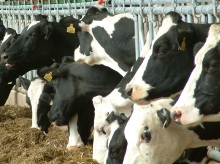 Silage
additives have a cost, equivalent to 3 - 5 pence per cow per day. A large number of trials with dairy
cows have shown an average milk yield response, irrespective of weather conditions of up to 1.5 litres
per cow per day. So for less than 5 pence you are likely to get back 45 - 65 pence, on every cow, every day.
Not a bad investment.
Silage
additives have a cost, equivalent to 3 - 5 pence per cow per day. A large number of trials with dairy
cows have shown an average milk yield response, irrespective of weather conditions of up to 1.5 litres
per cow per day. So for less than 5 pence you are likely to get back 45 - 65 pence, on every cow, every day.
Not a bad investment.
You will of course also have more silage to feed and silage of better quality. On average with grass silage, additive treatment has been shown to cut fermentation and storage dry matter losses by about 45 tonnes for every 1000 tonnes treated.
Not using a silage additive definitely costs you money!
Silages have also been shown to have more true protein, more energy and higher digestibility when treated with a good quality inoculant resulting in improved animal performance. So not using a silage additive is not saving money, it is costing money. There will be less silage to feed out and animals are likely to produce less and require more concentrates.
8. How much money will I save by using a silage additive?
If savings in silage DM losses cover the cost of the silage additive and cows give an extra 1.5 litres per day @ 45 ppl then on 100 cows you could potentially make an extra £65 worth of milk per day or £13,000 over a 200 day winter. Alternatively you could save some concentrates or keep fewer cows saving money. Personally I would go for the extra milk. Back to top
9. Why should I use a maize additive?
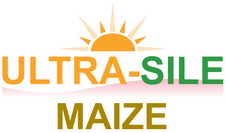 Maize
crops generally come in clean without high levels of soil contamination, clostridia, nitrogen and always
have plenty of fermentable sugars. Consequently maize silage never goes butyric and is usually between
25% and 40% DM and is therefore a relatively easy crop to ferment. Many farmers who always use an additive
on grass silage, don't bother to use a maize additive.
Maize
crops generally come in clean without high levels of soil contamination, clostridia, nitrogen and always
have plenty of fermentable sugars. Consequently maize silage never goes butyric and is usually between
25% and 40% DM and is therefore a relatively easy crop to ferment. Many farmers who always use an additive
on grass silage, don't bother to use a maize additive.
Often their main criteria for using a maize additive has been to improve face stability. Some have used a homo-fermentative inoculant which will give a very rapid fermentation but which produces only lactic acid. Lactic acid is rapidly broken down by lactate assimilating yeast in situation where silage begins to heat on the face. They have then concluded, mistakenly, that there is no point using a maize additive on forage maize silage.
My view is that it is indeed, very cost effective to treat forage maize with an appropriate hetero-fermentative inoculant. Additive treatment of maize will generally reduce dry matter losses in the clamp, improve feed intakes, improve face stability, reduce face heating, reduce mycotoxin levels and improve animal performance. Maize silage ferments in the same way as grass silage and for best results all forage maize should be treated with an effective maize additive such as Ultra-Sile Maize.
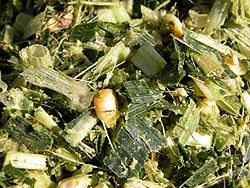 Typically, since maize silage is drier and undertakes a less extensive fermentation than wet
grass silages, I might expect around 4% reduction in fermentation and storage losses
compared with 4.5% - 5% in grass silage, as a result of using a silage additive.
Typically, since maize silage is drier and undertakes a less extensive fermentation than wet
grass silages, I might expect around 4% reduction in fermentation and storage losses
compared with 4.5% - 5% in grass silage, as a result of using a silage additive.
If we assume that silage additive treatment will cost between £0.85 and £1.20 per tonne treated and maize silage is worth £45 per tonne a 4% saving equates to an additional 40 tonnes of maize silage worth £1800 to feed for every 1000 tonnes treated. So even before taking account of improved feed value, fewer mycotoxins and improved animal performance it is definitely cost effective to treat all forage maize crops with a maize additive.
10. Is there any point using a silage additive on youngstock silages?
In the AIC Forage Additives Register 2005, 34 biological silage additives were registered as having demonstrated that they improved live weight gain. Each of these would have had at least 3 independent trials in order to have gained approval. A review of beef cattle trials confirm the economic benefits of inoculation of grass silages resulted in improvements in liveweight gain of 24% and increases in dry matter intake of 7% compared with animals fed untreated grass silage.
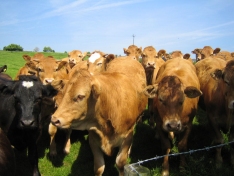 Typical increases in live weight gain on grass silage diets might be expected to
be around 0.1 to 0.15 kg per day along with improvements in feed conversion efficiency of up to 23%.
You might expect a dairy heifer to calve down 50kg heavier or 1 - 3 months earlier.
Typical increases in live weight gain on grass silage diets might be expected to
be around 0.1 to 0.15 kg per day along with improvements in feed conversion efficiency of up to 23%.
You might expect a dairy heifer to calve down 50kg heavier or 1 - 3 months earlier.
As well as increased growth rates there is scope for a reduction in concentrate use in order to reduce costs on heifers and growing beef animals.
On average silage additive treatment of grass silages has been demonstrated to reduce fermentation and storage losses in the clamp by around 4.5% equivalent to 45 tonnes of additional silage for every 1000 tonnes treated. This applies irrespective of weather conditions or the maturity level of the silage.
With silage additives costing between £0.90 and £1.30 per tonne treated if grass silage is valued at £30 per tonne savings in dry matter losses more than cover the cost of the silage additive before taking account of reduced losses due to heating at the face, or of increased growth rates or reduced concentrate costs.
There is absolutely no question that the failure to use a silage additive on silages for heifers, youngstock and beef cattle actually costs the farmer money. Back to top
11. Should I use a silage additive on big bale silage?
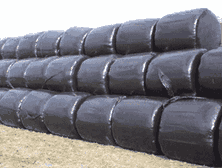 Yes.
Big bales ferment in exactly the same way as clamp silage. Treating big bale grass silage or Ag-Bagged
fermented forage crops whether grass, whole crop cereal or maize, with an inoculant, will yield the same
benefits as would a clamp. All fermented crops deserve to be treated with a silage additive.
Yes.
Big bales ferment in exactly the same way as clamp silage. Treating big bale grass silage or Ag-Bagged
fermented forage crops whether grass, whole crop cereal or maize, with an inoculant, will yield the same
benefits as would a clamp. All fermented crops deserve to be treated with a silage additive.
Trials have shown that additive treated bales often weigh 10% heavier after storage than untreated bales. Cows offered treated or untreated bales usually eat the treated bales first.
Many trials have demonstrated that youngstock, beef, heifers and lambs all improved growth rates on additive treated silage resulting in either reduced maintenance costs or reduced concentrate costs. Treatment costs of £0.50 to £0.90 per bale are easily justified even before taking account of improved animal performance. Silage additive applicators for big bales can be obtained from Selmech. Back to top
12. My silage heats on the face. Is it the fault of the silage additive?
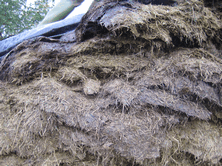 Heating
or aerobic spoilage at or just behind the silage face is due to a number of factors including consolidation,
clamp sealing, silage dry matter, chop length, maturity, sugar levels, nitrogen, protein levels
and buffering capacity which will in turn affect the extent of the fermentation and the amount of acid
present.
Heating
or aerobic spoilage at or just behind the silage face is due to a number of factors including consolidation,
clamp sealing, silage dry matter, chop length, maturity, sugar levels, nitrogen, protein levels
and buffering capacity which will in turn affect the extent of the fermentation and the amount of acid
present.
Crop contamination with yeasts and moulds will also have a bearing as will ambient temperature levels and rate of feed out.
Below 25% DM, well consolidated silage clamps rarely heat provided that usage rates are at least 15cms per day, face management is good and ambient temperatures are not above 10oC to 15oC irrespective of what silage additive is used. The problem is that above 30% DM, air can easily penetrate 1- 2 metres into the clamp which gives plenty of time for spoilage organisms to get to work. Once the silage starts to warm, spoilage speeds up and lactate assimilating yeasts can rapidly break down lactic acid.
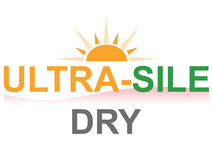 For this reason with dry silages it is unwise to use homo-lactic silage additives which produce
only lactic acid. Instead use biological additives based on hetero-fermentative strains of bacteria designed
for use on higher dry matter silages such as Ultra-Sile Dry or Ultra-Sile HiDri.
For this reason with dry silages it is unwise to use homo-lactic silage additives which produce
only lactic acid. Instead use biological additives based on hetero-fermentative strains of bacteria designed
for use on higher dry matter silages such as Ultra-Sile Dry or Ultra-Sile HiDri.
Often heating starts in the top third of the pit. This is due to poorer consolidation near the top, drier silages near the top and air present during the first days of the fermentation which allows spoilage organisms to multiply rapidly.
Silage Additives are no replacement for good management practices
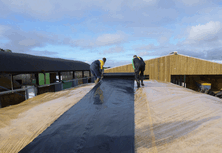 Heating
on the face can be influenced by choice of silage additive. The faster the initial part of the fermentation
down to pH 5, the less opportunity there is for spoilage organisms to multiply. Multi-strain inoculants
designed for a rapid start will help. Also using high specification silage additives with hetero-fermentative
strains which are capable of producing acetic, propionic and other acids will also help to reduce the risk of heating.
Heating
on the face can be influenced by choice of silage additive. The faster the initial part of the fermentation
down to pH 5, the less opportunity there is for spoilage organisms to multiply. Multi-strain inoculants
designed for a rapid start will help. Also using high specification silage additives with hetero-fermentative
strains which are capable of producing acetic, propionic and other acids will also help to reduce the risk of heating.
No silage additive can work effectively where the silage has not been rolled or where the clamp is not fully sealed
No silage additive can work effectively where the silage has not been rolled or where the clamp is not fully sealed. Shrinkage or DM loss can be cut by about 40 tonnes in a 1000 tonne clamp simply by increasing the density of the silage by a third. For best results aim for 25% - 28% DM, chop short, roll well, use direct cut grass on the top 1 - 2 metres, side sheet and sheet up as soon as the pit is full. Using a low transmission Passion Ag Oxygen Barrier Film has been shown to delay heating on the face by up to 5 days. But make sure that all edges and seams are completely air tight before applying nets, and tyres or lorry tyre side walls for additional weight. Having done that, wait at least 6 weeks before opening the pit and ensure that usage rates are at least 15cms /day in cold weather and at least 30 cms / day in summer. Back to top
13. My current silage additive has more trial work than other additives?
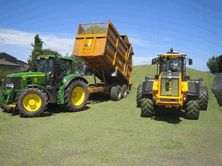 More
trial work doesn't necessarily mean a better product. Most silage additives put through independent research
trials use no silage additive as the control treatment. The aim being to gain a positive improvement
against using no additive for the purposes of obtaining registration with an approval scheme.
More
trial work doesn't necessarily mean a better product. Most silage additives put through independent research
trials use no silage additive as the control treatment. The aim being to gain a positive improvement
against using no additive for the purposes of obtaining registration with an approval scheme.
In many cases the companies that have invested the most in independent trials have been the most reluctant to update their products to incorporate the latest research, greater understanding of the silage making process and changes to forage conservation techniques.
Smaller specialised companies with a heavy on farm presence on the other hand have often been much more innovative and more able to respond to the changing needs of farmers. Back to top
14. My silage keeps running effluent. Is this due to the Additive?
Most biological inoculants actually reduce effluent losses, whilst acids can rupture the cell wall and increase effluent losses. When the UKASTA / AIC Forage Additives Register was still in operation in 2005 over half the inoculants registered, but none of the acids and salts, had gained approval for reduced effluent flow. Effluent contains valuable nutrients and should therefore be minimised. A rapid wilt to 26% - 30% DM should be the aim. Tedding immediately after mowing can result in a dramatic five fold increase in wilting rates.
Effluent flow is normally minimal above 25% dry matter but can be prolific below 20% DM. Not surprising when we consider that at 15% DM the clamp is 85% water, or not much thicker than milk. All silage clamps do produce some water. This is due to dry matter losses. The best fermentations have a fermentation loss of around 6% - 8%. A badly fermented grass silage may have fermentation and storage losses of over 30% which may reduce DM% by 2% - 3%. As organic matter is used as an energy source during the fermentation heat, carbon dioxide, acids and water are generated.
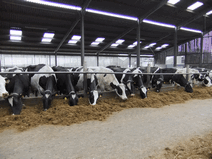 Using an inoculant increases the speed and efficiency of the fermentation, reduces energy lost as heat and reduces dry matter losses and therefore the amount
of water produced. Effluent flow is therefore reduced, in some cases showing more than a 20% reduction.
In contrast acids can increase effluent flow by over 40%.
Using an inoculant increases the speed and efficiency of the fermentation, reduces energy lost as heat and reduces dry matter losses and therefore the amount
of water produced. Effluent flow is therefore reduced, in some cases showing more than a 20% reduction.
In contrast acids can increase effluent flow by over 40%.
Wet grass silages need more acid to preserve them than dry grass silages and undergo a more extensive fermentation with higher fermentation losses and therefore slightly more water produced.
Air present at the start of the fermentation will delay fermentation and increase losses. As a general rule if the fermentation is good and the silage is stable losses will be low and the silage additive has done a good job. The better the fermentation at a given dry matter, the lower the losses.
Where the silage is badly fermented, butyric or unstable then dry matter losses will be higher and consequently the dry matter % of the silage will fall. This may be due to the silage additive failing to control the fermentation. This can be due to many reasons, for example, application issues, or a forage so high in clostridia, soil, nitrogen, or too low in DM or sugars to be capable of preservation under any circumstances. That said some additives cope much better than other in challenging situations.
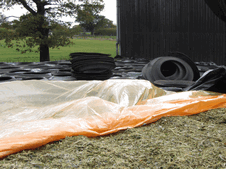 Most
times that clamps appear to get wetter and run more effluent it is due to rain water penetrating the
silage sheets on outside clamps. It is not uncommon to hold up a black sheet to sunlight to see it pin
holed all over due to bird damage or the claws of cats, dogs, foxes etc. In addition water often enters
at seams and shoulders.
Most
times that clamps appear to get wetter and run more effluent it is due to rain water penetrating the
silage sheets on outside clamps. It is not uncommon to hold up a black sheet to sunlight to see it pin
holed all over due to bird damage or the claws of cats, dogs, foxes etc. In addition water often enters
at seams and shoulders.
One metre of rain on 2 metres of 30% DM silage could reduce the clamp to around 17% DM if it all entered evenly across the surface. In practice water often pools in low places and I have seen cases of 4 metre deep clamps of 28% DM silage reduced to 17% DM over 2 - 3 bays with a subsequent loss in milk yield of several litres per cow.
This is why constructing clamps with a slight dome, doing a thorough job of sheeting and then protecting the sheets with protective covers or nets is so important. The sides should be dished inwards slightly to channel water away from the walls and off the front of the pit. Generally using two plastic sheets is better than one. Ideally use Passion Ag or Silostop Oxygen Barrier Film, a black sheet and then a protective net.Back to top
15. Acid was always the best silage additive?
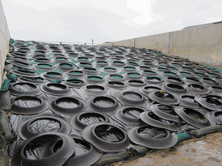 Acids
have lost popularity in the UK due to health and safety issues, corrosion of silos, concrete and machinery,
and also the high cost. Applying 5 litres of acid per tonne is far more costly than treating with an
inoculant additive. Contrary to popular belief applying 5 litres of acid per tonne of silage reduces the pH by very little. The clamp
still has to undergo a normal fermentation to reach a stable pH and may produce an additional
30 - 40 litres of lactic acid in order to stabilise the clamp.
Acids
have lost popularity in the UK due to health and safety issues, corrosion of silos, concrete and machinery,
and also the high cost. Applying 5 litres of acid per tonne is far more costly than treating with an
inoculant additive. Contrary to popular belief applying 5 litres of acid per tonne of silage reduces the pH by very little. The clamp
still has to undergo a normal fermentation to reach a stable pH and may produce an additional
30 - 40 litres of lactic acid in order to stabilise the clamp.
Acids do give an initial pH drop which may reduce some multiplication of clostridia, yeasts and spoilage organisms. They do however dramatically increase effluent losses in wet grass silages and improvements in intakes or animal performance have rarely been demonstrated. Increased effluent losses reduce sugar levels in the silage and rupturing the plant cell walls may aid consolidation. As a result stability may be improved but at a cost.
Another issue particularly with very dry crops is that an inoculant will grow and continue to ferment until the silage is stable, whereas acid will stay where it is put. Uneven or insufficient application of acid can cause major problems. Generally inoculants are far more user friendly, much cheaper and result in lower losses, better intakes and improved animal performance compared with an acid. Back to top
16. Will a preservative do a better job than an inoculant?
Food preservatives such as potassium sorbate, sodium benzoate and sodium nitrite do have a place. They are much safer to use than strong mineral acids but they are more expensive to use than inoculants particularly on low dry matter forages where the amount needed to stabilise a clamp would be prohibitive.
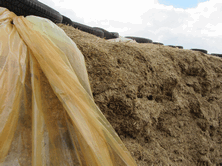 Once
the pH of the clamp has fallen to a low level preservative are very effective at controlling moulds,
yeasts and spoilage organisms.
Once
the pH of the clamp has fallen to a low level preservative are very effective at controlling moulds,
yeasts and spoilage organisms.
However preservatives have little effect at the start of the fermentation until the pH drops to below 5, unless they are applied at very high concentration. Spoilage organisms, yeasts and moulds multiply very rapidly above 5 pH and can multiply to very high levels where a preservative is applied without an inoculant and the pH is slow to drop.
Applying preservatives without an inoculant will not have the same advantages of an inoculant in controlling the fermentation, in conserving energy, in reducing protein degradation and in improving intake characteristics. Where we have seen this approach commercially even with very high levels of preservative which has been very costly, whilst face stability has been comparable to the best hetero-fermentative inoculants, dry matter intakes and animal performance have been reduced.
Dual action preservative inoculant combinations are more effective
than preservatives used alone
 Preservatives
used in a dual action combination with an effective inoculant can be very beneficial at only a small
additional cost over using an inoculant alone.
Preservatives
used in a dual action combination with an effective inoculant can be very beneficial at only a small
additional cost over using an inoculant alone.
The inoculant gives all the benefits of a rapid pH drop and an efficient fermentation aided by the preservative which will inhibit spoilage organisms as the pH drops resulting in good face stability in conjunction with a homo-lactic fermentation.
Dual action preservative inoculant combinations can be particularly effective where there is a high level of mould and yeast contamination on the crop in the field. Back to top
17. Aren't all biological silage additives pretty much the same?
Since the introduction of the UKASTA / AIC Forage Assurance Scheme which has now been followed the EU EFSA Approval Scheme we can be assured that all silage additives available in the UK are safe to use, meet quality standards and have demonstrated that they are effective and will show an improvement over un-treated silage. Registration however will not tell us which products are most effective or which are most appropriate for use in a given situation. Nor will a lot of the trial data often quoted by some silage additive companies as proof that their product is best.
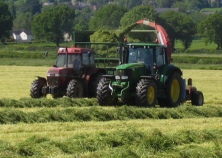 Research trials comparing a particular silage additive against un-treated
silage, do not give much if any of an indication which is the best product out there for a given set
of circumstances. For that you will need to consult someone who has the on farm experience and know how
to be able to advise.
Research trials comparing a particular silage additive against un-treated
silage, do not give much if any of an indication which is the best product out there for a given set
of circumstances. For that you will need to consult someone who has the on farm experience and know how
to be able to advise.
Unfortunately often the people asked to give advice on choice of product do not have the necessary experience or knowledge of working with silage additives day in day out to give an informed opinion.
There are wide variations in the specifications of silage additives available in the UK and also in the results that they produce.
This is quite a dilemma for the farmer since due to the complex nature of silage fermentation and the microbiology and biochemistry few farmers have the expertise to judge the benefits of one silage additive against another. The problem is made worse since it is not uncommon for silage additives to be inadvertently sold into an inappropriate situation where another product could have done a much better job.
If you are making perfect silage right to the sheet, with no waste and no feeding issues, stick with the additive that you are using. If not find a silage specialist who can give really good advice, and remember, silage additives are no replacement for good management practices. It may not be the silage additive that is the problem.Back to top
18. The silage additive I use is brewed on farm to save money?
There have been a number of reduced rate silage additives available over the years which have been supplied at a small discount over full strength products and designed to be grown on farm.
Brew your own silage additives have largely fallen from favour for a number of reasons. One problem is that very acid tolerant strains of bacteria are needed which can tolerate very low pH and high acidity levels in the fermentation drum should silaging be delayed for a day or two.
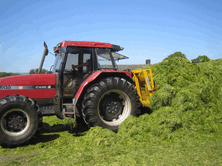 As with a silage fermentation they will continue to ferment
in the drum until they are killed by the acidity and low pH. These products
are usually fast fermenting homo-lactic strains which are easy growers and have a shorter brewing time
than hetero-fermenters.
As with a silage fermentation they will continue to ferment
in the drum until they are killed by the acidity and low pH. These products
are usually fast fermenting homo-lactic strains which are easy growers and have a shorter brewing time
than hetero-fermenters.
Very acid tolerant strains of bacteria used in brew your own products are however, likely to ferment excessively in the clamp, using up more of the sugar, producing excessive amounts of lactic acid, which in term will increase the amounts of fermentation losses, and produce very low pH silages.
At the same time fully homo-lactic product do tend to produce silages which are prone to heating at the face in silages above about 25% DM. It is precisely for these reasons that many farmers have moved away from brew your owns to full spec freeze dried instant silage additives.
There have also been issues with heater elements failing and the silage additive not growing and issues with cross contamination where spoilage organisms have got into the brew. Also harvesting has to be anticipated ahead of time and if there is a delay then the brewed silage additive is either compromised or wasted completely.
In view of the fact that at current prices there can be a 10 : 1 return on the money spent on a normal full spec instant silage additive it is no wonder that brew your own products have fallen by the way side. Save 10% of the cost and risk losing 1000%. Back to top
19. How can I reduce spoilage and dry matter losses?
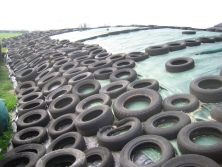 Dry matter losses during fermentation
and storage in silage pits range from about 7% to over 30%. All silages will lose some energy and dry
matter even in an efficient fermentation from respiration and as sugars are fermented to acids as part
of the acidification process.
Dry matter losses during fermentation
and storage in silage pits range from about 7% to over 30%. All silages will lose some energy and dry
matter even in an efficient fermentation from respiration and as sugars are fermented to acids as part
of the acidification process.
All effluent will contain dry matter which is another source of dry matter losses. In addition there may be further losses due to heating at the face and un-feedable spoiled silage which is discarded.
The challenge to silage makers is minimise those losses and finish up with a stable silage at feed out which has a feed value as close as possible to the crop when it was cut. The aim should be to have no visible spoilage or waste on the pit, and this is achievable.
In order to achieve low DM losses below 10% and no visible spoilage everything has to be done right with attention to detail and no corners cut. In short observe good silage management practice throughout.
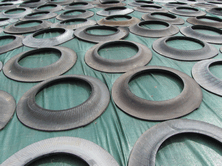 Here are some of the
factors to consider. Grow a good clean crop in the field and use a mower conditioner. With grass silages
a rapid wilt to 25% - 28% dry matter (may only need 2 - 4 hours). Make sure you have a clean clamp, clean
yard, gateways and tracks.
Here are some of the
factors to consider. Grow a good clean crop in the field and use a mower conditioner. With grass silages
a rapid wilt to 25% - 28% dry matter (may only need 2 - 4 hours). Make sure you have a clean clamp, clean
yard, gateways and tracks.
Always use an effective silage additive, short chop, roll well with heavy machines and narrow tyres. Roll no more than 15cms at a time. Dish the sides so the rolling gets right to the wall. Save some wet forage for the top metre where possible.
The clamp should be slightly domed to run off water but do not overfill the clamp. Have no shoulders or ramps greater than 30o slopes. Use Oxygen barrier film rather than cling film, side sheet with Oxygen barrier wall film, then a black sheet on top, then a net, and then apply weight evenly over the surface of the net. Tyres or lorry tyre sidewalls work well.
Use a quality inoculant designed for improved face stability
such as Ultra-Sile Dry or Ultra-Sile HiDri
 Where crop dry matters are greater
than 28% DM or usage rates are low use a quality inoculant designed for improved face stability such
as Ultra-Sile Dry, Ultra-Sile HiDri, Ultra-Sile Maize or Ultra-Sile Arable.
Where crop dry matters are greater
than 28% DM or usage rates are low use a quality inoculant designed for improved face stability such
as Ultra-Sile Dry, Ultra-Sile HiDri, Ultra-Sile Maize or Ultra-Sile Arable.
Sheet immediately the pit is filled. All seams and edges must be airtight. Use gravel bags at edges and seams, bottom of the ramp and across the face. Tape the seams if necessary. Ideally do not open the clamp for at least 6 weeks.
At feed out use a block cutter or defacer and keep the clamp area clean. Ensure that usage rates are more than 15 cms in the winter and more than 30 cms in the summer. If this can't be achieved then redesign the clamping systems. Back to top
20. How can I improve the ME and protein of my silages?
If ME and protein levels of your silage are low then they can be improved. But remember a silage additive is not a replacement for good management practices. A silage additive will reduce losses in DM and energy and will keep more of the protein in an intact form that can be utilised directly by the animal but it will not turn a low digestibility, low protein forage into something better. Silage is never as good as the crop in the field. The best we can do is minimise losses and keep its feed value as close as possible to the fresh cut crop. Avoid long wilting periods. Rapid wilting reduces losses of both energy and protein.
The UK went through a period of cost cutting and corner cutting where some of the basic principles of grass silage making were largely forgotten. The move away from 3 and 4 cut systems, to 2 cut systems in an attempt to save money on contractors, has cost the industry a fortune in lost production, increased concentrate costs and animal health issues. Grass quality not yield is the key to making quality silage.
Cut 1st cut early and then cut every 5 - 6 weeks.
Always use a good silage additive
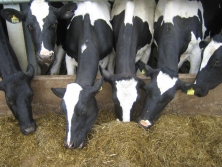 The
digestibility, ME and crude protein falls dramatically as a crop of grass reaches maturity. Once ear
emergence is reached a 7 day delay in cutting will result in a loss of 3-4 units of D-value and increase
the need for concentrates by around 1.5kgs per cow per day. Late headed varieties will reach optimum
cutting date up to 2 weeks before ear emergence. Lodged crops will lose about 1 unit a day in D-value.
So cutting early, really is of paramount importance and affects cow performance for the whole year.
The
digestibility, ME and crude protein falls dramatically as a crop of grass reaches maturity. Once ear
emergence is reached a 7 day delay in cutting will result in a loss of 3-4 units of D-value and increase
the need for concentrates by around 1.5kgs per cow per day. Late headed varieties will reach optimum
cutting date up to 2 weeks before ear emergence. Lodged crops will lose about 1 unit a day in D-value.
So cutting early, really is of paramount importance and affects cow performance for the whole year.
If you don't believe me try grazing a first cut grass silage in July. Yet there was a trend to delay cutting 1st cut until well into June and cutting 2nd cut in August or September. Aim for 1st cut early in May if conditions permit, and subsequent cuts 5 -6 weeks apart. Aim for 3 or 5 cuts per year.
Rotational grazing system work on around 3 week intervals for optimum performance. Cutting grass silage at 2 - 3 months between cuts is too long and will result in low protein, low digestibility silages. Cut more often and you will grow more forage in a season of higher quality. You will have more production from your cows, use less concentrates and have fewer herd health issues.
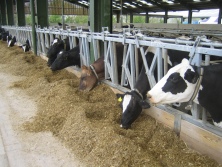 Other areas to look at. Reseed regularly using the best digestibility grass seed varieties
available. Don't skimp on the fertiliser and check that other soil nutrients are in balance. Sulphur deficiency is a very common cause of poor fertiliser nitrogen utilisation and low protein levels in silage.
Other areas to look at. Reseed regularly using the best digestibility grass seed varieties
available. Don't skimp on the fertiliser and check that other soil nutrients are in balance. Sulphur deficiency is a very common cause of poor fertiliser nitrogen utilisation and low protein levels in silage.
Go for a
rapid wilt to 25% - 28% DM. Do a decent job of rolling and sealing the clamp. Prolonged wilts or air
present during the fermentation can both cause a lot of energy and protein to be lost. Always treat
with an effective, well proven silage additive. Back
to top
21. Why hasn't the silage additive worked?
In the vast majority of cases where the silage additive is suspected of not working it is down to management issues. There have been cases where applicator filters have been blocked and the silage additive hasn't been applied.
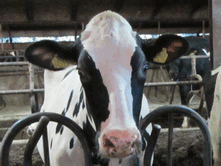 We do see plenty of cases where the silage additive selected was unsuitable
for the crop for example homo-lactic inoculants applied to 30% - 50% DM grass crops with high sugar levels,
destined for feeding in high temperature in the summer at very low feed out rates.
We do see plenty of cases where the silage additive selected was unsuitable
for the crop for example homo-lactic inoculants applied to 30% - 50% DM grass crops with high sugar levels,
destined for feeding in high temperature in the summer at very low feed out rates.
We also see situations where the additive used in difficult ensiling conditions was not up to the job.
But generally the problems on wet grass silages relate to soil and slurry contamination combined with high nitrogen levels. On dry silages problems are usually down to lack of consolidation on over wilted, dry, long chopped, stalky, high sugar silages in combination with inadequate clamp sealing, holes in sheets and low feed out rates in warm conditions.
For best results the clamp should well consolidated and sealed immediately paying attention to air tight sealing at the edges. Ideally the clamp should then be kept un-opened and air tight for several weeks. For a better understanding of the silage fermentation process see The Biology of Silage Preservation.Back to top
22. My silages are low in energy. Would a different silage additive help?
Probably not, if the fermentation is good and the silage isn't heating on the face. Chances are your grass crops are low in energy when they were cut. Cut earlier and more often. Re-seed with the latest High D-Value grass varieties. Check soil nutrients, lime, fertiliser levels etc. Having done that, then see if you can improve your ensiling techniques or silage additives. Back to top
23. Are there better silage additives out there?
Technology and our understanding of the silage making process continues to develop as do silage additives. All silage additives available in the UK have to conform to EU standards of quality, safety and efficacy. This means that they are safe to use and will show an improvement but still the capability of different silage additives varies widely. There are still silage additives widely sold that were developed in the 1980's and are still virtually the same spec. Ask yourself, technology has moved on, why haven't these additives?
Take a look at the new Ultra-Sile Range of Silage Additives
Take a look at the Ultra-Sile Silage Additive Range developed by Richard Webster Nutrition Ltd. This is a very versatile range of high specification silage additives which will continue to improve and develop as new developments occur. The Ultra-Sile Silage Additive Range is effective in preserving a wide range of forages including high dry matter grass silages, big bales, maize silage, wholecrop cereal silage and crimped cereals. Ultra-Sile Silage Additives are available to farmers throughout the UK.
Back to top24. Will an inoculant work in very wet and dirty conditions?
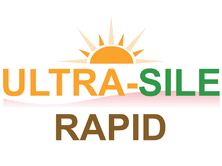 In very wet conditions there are situations where grass is so immature, low in sugar, high
in nitrogen and protein and so badly contaminated with soil, slurry and clostridia that it simply is
not possible to ensile and achieve a good fermentation under any circumstances.
In very wet conditions there are situations where grass is so immature, low in sugar, high
in nitrogen and protein and so badly contaminated with soil, slurry and clostridia that it simply is
not possible to ensile and achieve a good fermentation under any circumstances.
However a good high spec homo-fermentative inoculant will usually cope well with wet conditions and low sugar levels and would be our product of choice on wet grass silage.
Ultra-Sile Rapid and Ultra-Sile AD are high specification, multi-strain homo-fermentative additives and includes a finishing strain Lactobacillus paracasei which is capable of producing fructanase enzyme to produce additional sugars from fructans in order to complete the fermentation. We have found these products particularly effective in treating very wet grass silage in challenging situations and we have rarely seen a bad or butyric fermentation, even in some exceptionally difficult conditions.
25. What is the best silage additive to prevent silage going butyric?
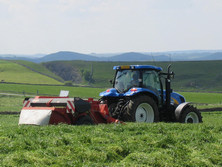 Silages
which are in danger of going butyric are almost always, very wet, low in sugar, high in nitrogen and
protein, immature, with soil or slurry contamination and with high levels of clostridia present. Clostridia
which produce butyric acid, thrive in cold wet grass silages and produce butyric acid, break down protein
producing a variety of foul smelling amides, amines and ammonia.
Silages
which are in danger of going butyric are almost always, very wet, low in sugar, high in nitrogen and
protein, immature, with soil or slurry contamination and with high levels of clostridia present. Clostridia
which produce butyric acid, thrive in cold wet grass silages and produce butyric acid, break down protein
producing a variety of foul smelling amides, amines and ammonia.
Fortunately clostridia will not tolerate a very acidic environment. Any inoculant which drops the silage pH rapidly should prevent a butyric fermentation, provided that there are enough silage additive bacteria to control the fermentation when there are very high levels of clostridia present.
This type of grass silage will be high in buffering capacity and contain a lot of water, consequently a lot of acid is required to stabilise it and it will need to undergo a very extensive fermentation. Lactic is the strongest acid and homo-lactic fermentative strains will produce more acid using less sugar, faster under these conditions, so a conventional multi-strain lactic inoculant would be the product of choice.
I have hardly ever seen a butyric fermentation where
Ultra-Sile Rapid or Ultra-Sile AD have been applied at full strength
Multi-strain, high specification silage additives which apply a sufficiently high level of inoculant bacteria to dominate the fermentation and which contains an effective starter strain will cope with some very difficult challenges.
Ultra-Sile Rapid or Ultra-Sile AD would do particularly well since they include Lactobacillus paracasei. Lactobacillus paracasei can produce fructanase enzyme and produce more soluble sugars from fructans in order to complete the fermentation when sugar levels are very low. This is a better option than adding enzymes which may cause shrinkage, increased effluent etc if the pH doesn't stabilise.
Equally there would be little point using a preservative alone since the amount required would be too great and preservatives only become really effective once the pH has dropped to a low level. Of course a preservative could be used at a lower rate alongside an inoculant in really difficult situations where there are very high levels of clostridia from soil and slurry present, as an additional insurance. But to be fair I have hardly ever seen a butyric fermentation where Ultra-Sile Rapid or Ultra-Sile AD are applied. Back to top
26. My high lactic acid, low pH silage is causing acidosis?
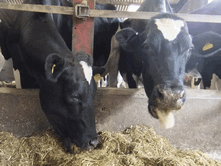 In a well fermented silage sufficient acid needs to be produced to stabilise and preserve the silage.
Consequently high lactic acid should not necessarily be considered a bad thing. Much more preferable
to a silage where the fermentation ran out of sugars which restricted the fermentation
and where the silage turned butyric. In the latter case there will be less lactic acid and a higher
pH but the silage will have high dry matter losses, low sugars, be less palatable and support less animal
performance.
In a well fermented silage sufficient acid needs to be produced to stabilise and preserve the silage.
Consequently high lactic acid should not necessarily be considered a bad thing. Much more preferable
to a silage where the fermentation ran out of sugars which restricted the fermentation
and where the silage turned butyric. In the latter case there will be less lactic acid and a higher
pH but the silage will have high dry matter losses, low sugars, be less palatable and support less animal
performance.
Much more acid is required to preserve the silage if it is wet or has a high buffering capacity due to high levels of protein, nitrogen or soil contamination. A stable pH needs to achieved whether from lactic, acetic, propionic or other acids. With the notable exception of a couple of brew your own silage additives which have been widely sold in the UK, and which do have a reputation for producing very high lactic acid levels and taking the pH lower than is needed whether in homebrew or instant forms, most additives will not produce excessive amounts of lactic acid.
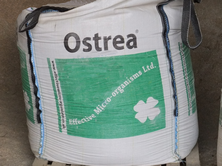 Lactic
acid can be minimised simply by efficient wilting to above 25% dry matter where ever possible. It should
however be argued that lactic acid is not the main or usual cause of acidosis in dairy cows.
Lactic
acid can be minimised simply by efficient wilting to above 25% dry matter where ever possible. It should
however be argued that lactic acid is not the main or usual cause of acidosis in dairy cows.
A proportion of most herds will be suffering from acidosis most of the time even if at a sub-clinical level where there are no symptoms other than a lack of performance, poor feed efficiency and a higher concentrate feed rate than is necessary for the milk yields produced. There are sound arguments for including Ostrea rumen buffer and a live yeast in diets as standard.
The main cause of acidosis is due to lack of scratch fibre when feeding very high digestibility forages or more frequently the feeding of excessive levels of starchy concentrates in an attempt to compensate for the low energy and low intake characteristics of many silages. Often the acidity of the silage is mistakenly blamed rather than the quality of the silage.
Lactic acid is a very good energy source for the cow and often much more lactic acid is created in the rumen when cows are fed large amounts of starch and are suffering from rumen acidosis, than is contributed by the silage. Beware of colour coded silage additive reports. A wet high lactic acid silage might contain over 200g/kg lactic acid, yet regularly we are told that maize silage is causing acidosis because the report shows lactic acid in the red with lactic acid at 60g - 70g/kg.
Some but not all live yeasts are very effective at mopping up excess lactic acid in the rumen. Biocell Yeast is particularly effective. If your cows are suffering from acidosis then there are lots of things that a good nutritionist can do to rectify the problem. Back to top
27. Why use anything other than Lactobacillus plantarum?
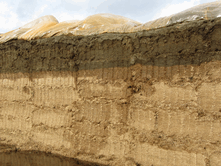 Lactobacillus plantarum is a perfectly good homo-fermentative strain which produces lactic acid efficiently.
It is not the only strain out there which produces good results and is not the most suitable for all
situations. All strains have their limitations and none work at their best throughout the whole range
of conditions found during the course of a fermentation.
Lactobacillus plantarum is a perfectly good homo-fermentative strain which produces lactic acid efficiently.
It is not the only strain out there which produces good results and is not the most suitable for all
situations. All strains have their limitations and none work at their best throughout the whole range
of conditions found during the course of a fermentation.
Trial work has shown that faster and more reliable fermentations can usually be achieved by using a multi-strain product. Some of the Pediococcus strains are better starters where pH is high, temperatures are often high and more oxygen is present. Completing the first part of the fermentation down to pH 5 very rapidly is particularly important in reducing protein break down and in reducing the multiplication of clostridia, yeasts, moulds and other spoilage organisms.
Other strains such as Lactobacillus casei and Lactobacillus paracasei are very rapid fermenters. Lactobacillus casei is very effective at removing oxygen from the clamp and therebye increasing speed of fermentation reducing losses and inhibiting spoilage organisms.
Whilst Lactobacillus plantarum is a very good finishing strain in situations where silages are very wet and low in sugar. Lactobacillus paracasei is capable of converting fructans to soluble fructose sugar when sugars are in short supply in order to complete the fermentation more effectively than Lactobacillus plantarum once all the soluble sugars are used up.
 On dryer
silages above 26% dry matter or where aerobic stability and heating at the silage face is the main concern
we would use Lactobacillus casei in conjuction with hetero-fermentive strains or use hetero-fermentative
strains exclusively which tend to produce lower levels of lactic acid and are capable of producing higher levels
of volatile fatty acids (VFA's) including acetic acid and propionic acid which aid stability
and reduce heating at the silage face.
On dryer
silages above 26% dry matter or where aerobic stability and heating at the silage face is the main concern
we would use Lactobacillus casei in conjuction with hetero-fermentive strains or use hetero-fermentative
strains exclusively which tend to produce lower levels of lactic acid and are capable of producing higher levels
of volatile fatty acids (VFA's) including acetic acid and propionic acid which aid stability
and reduce heating at the silage face.
28. Are multi-strain better than single strain inoculants?
Dependant on the strains of inoculant bacteria used, multi-strain products can result in a faster fermentation than single strain products. Different strains work faster and are more efficient at different pH and oxygen levels, temperatures and osmotic pressures. The use of multiple strains has the advantage of a faster fermentation and more reliable results over a wide range of conditions. All Ultra-Sile inoculants are multi-strain.
29. How important are the number of bacteria applied?
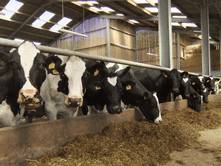 The crop will contain a wide range of 'wild' micro-organisms.
Many of these are spoilage organisms and are undesirable. Inoculant bacterial strains multiply very rapidly
and at a faster rate than other microbes naturally present. The silage additive needs to be applied with
sufficient inoculant bacterial numbers to dominate the fermentation. This allows the inoculant to completely out
compete other microbes so that almost all the fermentation is carried out by the elite, efficient selected
strains supplied by the silage additive.
The crop will contain a wide range of 'wild' micro-organisms.
Many of these are spoilage organisms and are undesirable. Inoculant bacterial strains multiply very rapidly
and at a faster rate than other microbes naturally present. The silage additive needs to be applied with
sufficient inoculant bacterial numbers to dominate the fermentation. This allows the inoculant to completely out
compete other microbes so that almost all the fermentation is carried out by the elite, efficient selected
strains supplied by the silage additive.
The actual number of CFU's of bacteria needed to dominate a fermentation will depend on the effectiveness of the strains selected and the numbers of spoilage organisms present. Generally speaking 300,000 CFU / gram of forage is almost always adequate. Lower levels may be problematic and not always achieve an adequately controlled fermentation. 1 million CFU products may be used for particularly difficult situations but be aware that a 300,000 CFU multi-strain additive will often out perform a 1 million CFU single strain silage additive.Back to top
ULTRA-SILE SILAGE ADDITIVES
30. Are Ultra-Sile Silage Additives new?
The Ultra-Sile Range is the result of ongoing development of the range by Richard Webster Nutrition Ltd over more than twenty years. Products within the range are continually updated to take account of the latest technological developments. Back to top
31. Why haven't I heard about Ultra-Sile Silage Additives before?
The Ultra-Sile brand which is exclusive to Richard Webster Nutrition Ltd is widely sold within the UK. Emphasis is placed on providing a very high quality, high specification product at a very competitive price. Our low overhead costs allow us to offer more effective, higher specification products at lower prices. These products sell themselves on farmer to farmer recommendation without the need for a large advertising and marketing budgets and without the high cost of an on farm sales force.
32. How was the Ultra-Sile Range developed?
In 2002 RWN Ltd and a group of other independent agricultural merchants with a lot of experience in the UK silage additive market began to develop an improved range of silage additives. At that time there were over 50 silage additives registered on UK Forage Additives Register all backed by independent research trials.
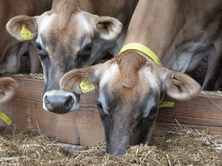 Whilst
there had been a lot of progress in silage additive research very little of this new knowledge was being
adopted by manufacturers for the simple reason that most of them had made major investments in independent
research trials in order to get registration and also heavily invested in marketing. Any change to the
registered products would have meant re-doing all the trial work over several years at huge expense which
could not be justified commercially.
Whilst
there had been a lot of progress in silage additive research very little of this new knowledge was being
adopted by manufacturers for the simple reason that most of them had made major investments in independent
research trials in order to get registration and also heavily invested in marketing. Any change to the
registered products would have meant re-doing all the trial work over several years at huge expense which
could not be justified commercially.
Another issue was that when inoculants were widely introduced in the early 1980's they were designed to treat typical wet UK grass silages of the time at around 18% - 24% DM, often early cut with high levels of soil contamination and excess nitrogen which had a tendency to go butyric and run a lot of effluent. 20 years on, average silages in the UK had increased to an average of 33% DM largely as a result of the introduction of improvements in machinery, particularly mower conditioners. The problems had changed from a high risk of going butyric, to drier silage, less well consolidated and less well sheeted prone to heating and moulding on the face.
Most products on the UK market were homo-fermentative lactic acid type inoculants which whilst very effective on wet silage weren't well suited to modern drier silages. The fact that they all had independent trials showing that they were beneficial compared with no silage additive on wet silage in a well-managed research unit didn't mean that they were the best suited to a 40% DM poorly consolidated, late cut silage on a commercial farm.
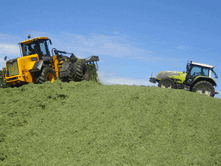 We
knew that there was room for improvement and as a result the Gold Shake Range of silage additives was
developed. This was the pre-cursor to The Ultra-Sile Range. The range was developed and manufactured in conjunction with a major UK biotechnology company,
with a very experienced microbiologist with whom we could work closely and who was able to conduct all
the necessary lab trial work.
We
knew that there was room for improvement and as a result the Gold Shake Range of silage additives was
developed. This was the pre-cursor to The Ultra-Sile Range. The range was developed and manufactured in conjunction with a major UK biotechnology company,
with a very experienced microbiologist with whom we could work closely and who was able to conduct all
the necessary lab trial work.
Field trial work and testing has been carried out by Richard Webster over a number of years by splitting clamps on commercial farms and comparing directly against other silage additives, rather than against an untreated control. This approach of trialling under a wide range of conditions on real silage clamps, on local farms was able to quickly establish a clear advantage over other widely used silage additives.
We then went on to develop products specifically targeted at drier grass silages, whole crop silage and forage maize. Again by trialling against other silage additives on commercial farms we were able to demonstrate improvements in fermentation quality and aerobic stability.
Ultra-Sile silage Additives have over 10 years' worth of
field testing and trials on
local farms
After 10 years of rapid development and sales rocketing Richard Webster Nutrition launched the new Ultra-Sile Range of silage additives which is more comprehensive, more versatile and with some new refinements. Back to top
33. My current supplier says that Ultra-Sile Additives are not tested?
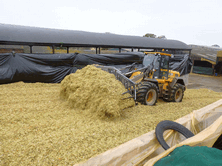 Some
silage additive manufacturers do rely very heavily on trials at independent research institutes from
the 1980's and 1990's as a means of selling their
product. Silage additives were normally trialled against a control with no additive. Much valuable work
was done in this way 20 - 30 years ago which has greatly extended our understanding
of silage making.
Some
silage additive manufacturers do rely very heavily on trials at independent research institutes from
the 1980's and 1990's as a means of selling their
product. Silage additives were normally trialled against a control with no additive. Much valuable work
was done in this way 20 - 30 years ago which has greatly extended our understanding
of silage making.
However showing that a silage additive is beneficial compared with no additive, on a particular grass silage, 20 years ago is not the same as comparing two products on very different silages under a wide range of conditions on commercial farms today. Silage making techniques have changed a lot since the 1980's and commercial farms have different challenges to silages produced for trial purposes at research institutes.
Ultra-Sile silage additives were originally based on products which had approval under the AIC Forage Additives Approval Scheme which required submission of at least 3 independent trials for each category of approval, improving fermentation, aerobic stability, effluent, ensiling losses, feed intake, digestibility, efficiency, live weight gain, milk production. The original formulations have undergone continued development resulting in the very advanced Ultra-Sile silage additives that we have today.
 All strains of bacteria used are registered with European Food Safety Authority (EFSA) regulation 1831/2003
which covers silage additives which again requires extensive dossiers covering quality, safety, and efficacy.
All strains of bacteria used are registered with European Food Safety Authority (EFSA) regulation 1831/2003
which covers silage additives which again requires extensive dossiers covering quality, safety, and efficacy.
In addition Ultra-Sile silage additives are based on the Gold Shake Range of products which Richard Webster has trialled and field tested on commercial farms over 10 years in direct comparison with other commercial silage additives and with consistently outstanding results.
Ultra-Sile silage Additives have been tried and tested on local farms over 15 years
We have proven many times over, that silage additives work and that silage additives are cost effective. The challenge is to identify which formulations are most effective and under what conditions. Back to top
34. Does Ultra-Sile have any trial work?
All active ingredients used in Ultra-Sile have been fully trialled in accordance with EU1831(2003). In addition Ultra-Sile silage additives are based on the Gold Shake Range of products which Richard Webster has trialled on commercial farms over 10 years in direct comparison with other commercial silage additives and with consistently outstanding results. Back to top
35. Are Ultra-Sile silage additives fully approved and registered?
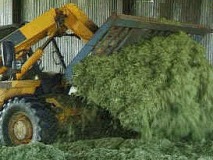 Ultra-Sile
silage additives are manufactured in the UK by a specialist manufacturer who is assured under the Feed
Materials Assurance Scheme and also with the Food Standards Agency under the Feed Hygiene Regulations.
FEMAS is based on HACCP principles, a system forming the bedrock of EU Food and Feed legislation.The
scheme is audited and certified by an independent certification body, in accordance with the internationally
recognised standard EN45011 (also known as ISO Guide 65).
Ultra-Sile
silage additives are manufactured in the UK by a specialist manufacturer who is assured under the Feed
Materials Assurance Scheme and also with the Food Standards Agency under the Feed Hygiene Regulations.
FEMAS is based on HACCP principles, a system forming the bedrock of EU Food and Feed legislation.The
scheme is audited and certified by an independent certification body, in accordance with the internationally
recognised standard EN45011 (also known as ISO Guide 65).
Ultra-Sile Range of Biological Silage Additives are EU Approved
Ultra-Sile silage additives are fully compliant with European Food Safety Authority (EFSA) regulation 1831/2003 which covers silage additives.
All active ingredients used in the Ultra-Sile Range have been fully trialled and have registration under EU1831(2003)
All silage additives along with feed additives must now be approved before being allowed on the market. This requires the submission of an extensive dossier covering quality, safety and efficacy. All silage additives must now show the individual strains of bacteria used and their approval numbers along with the total numbers of bacteria as cfu/g of product. It is an offence to treat silage with a non-approved additive. Back to top
36. Why are Ultra-Sile silage additives better?
There are many reasons why one silage additive may be better than another. These include number of bacteria, individual strains and inclusion levels, viability of the bacteria, other nutrients included, appropriateness of a particular formulation to a particular situation and range of conditions, technical backup and selection of the most appropriate product for the job.
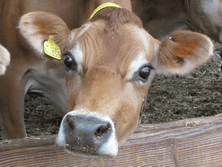 The
Ultra-Sile Range of silage additives scores very well in respect of these parameters. The products are
very highly spec'd multi-strain inoculants using very effective strains of bacteria with excellent vigour.
The
Ultra-Sile Range of silage additives scores very well in respect of these parameters. The products are
very highly spec'd multi-strain inoculants using very effective strains of bacteria with excellent vigour.
The range is probably the most extensive and versatile range of additives in the UK with products to meet the needs of a very wide range of scenarios. In addition Ultra-Sile is backed by a very high level of technical support with sound advice on product selection and silage making issues.
We believe that the Ultra-Sile Range of Silage Additives is second to none
Ultra-Sile silage additives have been developed by Richard Webster through a process of ongoing development over more than 15 years to treat silages under the conditions found today on local farms in the UK. If there has been scope to improve a product or to offer a better product to meet the needs of a particular situation we have done so.
 A
good example of this is with our high dry matter products. As silages in the UK have become drier in
recent years and more farms have had clamps open during the summer aerobic stability has become a big
issue. Many of the products already on the market were in our view unsuitable homo-lactic products or
inadequately specified.
A
good example of this is with our high dry matter products. As silages in the UK have become drier in
recent years and more farms have had clamps open during the summer aerobic stability has become a big
issue. Many of the products already on the market were in our view unsuitable homo-lactic products or
inadequately specified.
As a result we have developed a range of silage additives specifically to meet the needs of higher DM forages which have consistently given improved fermentation quality combined with improved stability and reduced heating at the face compared on commercial farms.
Some companies offer one product only which they claim will be the product of choice in all situations but usually ends up being a compromise in most situations.
Some companies silage additives are sold worldwide and as a result have been reluctant to tailor their products to meet the needs of farmers in the UK in case the changes caused issues in the very different conditions overseas, again a compromise.
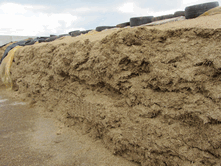 Some
companies offer a very limited range of products which were designed for very different conditions many
years ago and which haven't been updated to meet current needs of the UK farmer. They rely very heavily
on marketing and advertising or a large sales force to sell their products and have a very heavy investment
in to old trial data which they would no longer be able to sell off if they were to update products.
Some
companies offer a very limited range of products which were designed for very different conditions many
years ago and which haven't been updated to meet current needs of the UK farmer. They rely very heavily
on marketing and advertising or a large sales force to sell their products and have a very heavy investment
in to old trial data which they would no longer be able to sell off if they were to update products.
Ultra-Sile Silage Additives are at the leading edge of the forage additive market
Our approach has been very different approach we continue to develop our silage additives as new developments take place or as farmers needs change. We offer a very versatile range of very high spec competitively priced, multi-strain inoculants, together with some preservative options where needed. The Ultra-Sile Range is then backed up with some high quality technical advice relating to product selection and silage making techniques. Ultra-Sile additives really are at the leading edge of the forage additive market. Back to top
37. Why are there so many products in the Ultra-Sile Range?
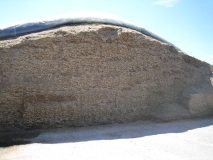 Fermented forages in the UK vary between 15% and 80% dry matter. There are wide variations in the levels of digestibility, fibre levels, ME, sugars, crude protein, nitrogen, soil, clostridia, mould and
yeast contamination between crops and between farms. Levels of consolidation, clamp sealing, usage rates
and face management vary widely. In addition some farms only feed during the winter with ambient temperature
below 5oC whilst others have clamps open all summer with ambient temperatures above 15oC.
Methods of application also vary.
Fermented forages in the UK vary between 15% and 80% dry matter. There are wide variations in the levels of digestibility, fibre levels, ME, sugars, crude protein, nitrogen, soil, clostridia, mould and
yeast contamination between crops and between farms. Levels of consolidation, clamp sealing, usage rates
and face management vary widely. In addition some farms only feed during the winter with ambient temperature
below 5oC whilst others have clamps open all summer with ambient temperatures above 15oC.
Methods of application also vary.
One product for all situations may perform reasonably for the majority of situations but won't give the best results all of the time. There are clearly marked advantages to having a versatile and specialised range of products to get the best result possible rather than compromising on efficacy for the sake of running with a very limited product range.
With Ultra-Sile you can select the silage additive or additives best suited to your individual farm circumstances. Back to top
38. Can I use one silage additive to treat all my crops?
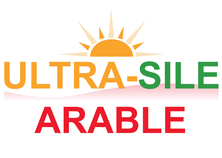 Yes.
Some farmers do use Ultra-Sile Dry on all crops with excellent results in terms of fermentation quality,
animal performance and face stability on a wide range of dry matters with 1st, 2nd, and 3rd cut grass
silage, whole crop silage, forage maize, crimped cereals and crimped maize.
Yes.
Some farmers do use Ultra-Sile Dry on all crops with excellent results in terms of fermentation quality,
animal performance and face stability on a wide range of dry matters with 1st, 2nd, and 3rd cut grass
silage, whole crop silage, forage maize, crimped cereals and crimped maize.
The number of products required depends on individual farms. It would not be advisable to use a homo-fermentative lactic inoculant on silages above 26% DM, particularly if high in sugar, loosely consolidated or where feed out rates are low, if you have problems with silage faces heating.
Equally it would not be sensible to use preservative based additives on very wet, low DM grass silages, or to use hetero-fermentative bacteria strains exclusively if you anticipate grass silage to be very wet, low in sugar, high in nitrogen and heavily contaminated with soil and slurry.
Most customers will use one or two different products from the Ultra-Sile Range during the season. Back to top
39. How many bacteria do Ultra-Sile inoculants apply?
Ultra-Sile biological products apply up to 1 million CFU per gram of forage applying higher concentrations of inoculant bacteria than many other products available in the UK. Many products on the market are specified at around 150,000 to 250,000 CFU. There are one or two exceptions at higher rates, generally single strain homo-fermenters.
 All
Ultra-Sile inoculants are multi-strain. It is important to supply sufficient CFU to dominate the fermentation
and this will depend on the strains of bacteria used, their vigour in multiplying and also on the level
of clostridia, spoilage organisms, yeasts, moulds etc. that are present.
All
Ultra-Sile inoculants are multi-strain. It is important to supply sufficient CFU to dominate the fermentation
and this will depend on the strains of bacteria used, their vigour in multiplying and also on the level
of clostridia, spoilage organisms, yeasts, moulds etc. that are present.
Failure to dominate the fermentation in difficult conditions can be a disaster result massive losses of dry matter and feed value. On the other hand there is little if any advantage in supplying more CFU's than is required to dominate the fermentation. Under optimum conditions many bacteria will double their numbers every 20 minutes.
Based on trial work and past experience with our silage additive products we can see no reason to exceed 1 million CFU with any of our multi-strain products. We rarely see a butyric silage treated with our products and farmers using Ultra-Sile continue to comment on the quality of fermentation of their silages. Back to top
40. Do Ultra-Sile additives apply 1 million Lactobacillus plantarum?
The Ultra-Sile Range contains products which apply up to 1 million CFU (colony forming units) of inoculant bacteria per gram of forage. Whilst Lactobacillus plantarum is used within the range, some products contain no Lactobacillus plantarum as other strains are more appropriate. The individual formulation depends on the type of forage and the conditions that the product is designed for.
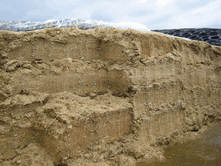 Lactobacillus
plantarum is a perfectly good homo-fermentative strain which produces lactic acid efficiently, but other
strains can be faster and more efficient at different pH, temperature, and oxygen levels.
Lactobacillus
plantarum is a perfectly good homo-fermentative strain which produces lactic acid efficiently, but other
strains can be faster and more efficient at different pH, temperature, and oxygen levels.
A bacterial strain such as Lactobacillus paracasei is a better option than many Lactobacillus plantarum strains in wet, low sugar conditions since it is able to use fructans as a source of fructose sugar to complete the fermentation when other sugars have all been used.
On very dry silages where aerobic stability on the face and prevention of heating is the main concern we would not want to include Lactobacillus plantarum but would use hetero-fermentative strains which are capable of producing acetic, propionic and other acids which will aid stability.
In our view using 1 million CFU of Lactobacillus plantarum as a single strain product would reduce the effectiveness of our multi-strain products both on very wet silages and on drier silages above 26% DM. Well formulated multi-strain products can work faster than single strain products over a wider range of conditions. Back to top
41. Will Ultra-Sile additives improve face stability and prevent heating?
Aerobic heating at the silage face depends on a number of factors. Most important are consolidation and usage rates. Good consolidation is much easier to achieve with low dry matter, young leafy material which will typically be lower in sugars and higher in protein and having undergone an extensive fermentation with a lot of acid present. Consequently it will be less prone to heating. Sometimes very wet silages go butyric and these almost never heat since they have lost most of the sugars present. They are more likely to rot than to heat.
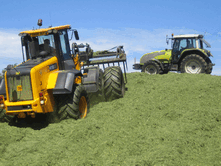 Heating problems can be minimised by cutting grass at high digestibility's, using a mower conditioner
and a short wilt of a few hours to achieve a dry matter of 25% - 28%. Far too many UK silages are over
wilted and are left in the swath to long whilst spoilage organisms build up on the crop and energy and
protein is lost in the field. Every day in the field will lose about 5% of the crop, mostly as sugars
used by crop respiration. Short rapid wilts are much more efficient.
Heating problems can be minimised by cutting grass at high digestibility's, using a mower conditioner
and a short wilt of a few hours to achieve a dry matter of 25% - 28%. Far too many UK silages are over
wilted and are left in the swath to long whilst spoilage organisms build up on the crop and energy and
protein is lost in the field. Every day in the field will lose about 5% of the crop, mostly as sugars
used by crop respiration. Short rapid wilts are much more efficient.
An additional tractor rolling the pit will help consolidation. Roll thin layers with something heavy. Dual wheels will apply half the ground pressure compared with single wheels. It is sometimes possible to fill two pits at the same time to allow more time for rolling.
Increasing the consolidation by a third will avoid over filled pits and reduce DM losses during fermentation and storage by around 4% as well as solving most face heating problems. If you can't push your fingers straight into a cleanly cut silage face past the nail, then you have done an adequate job of rolling and your pit is unlikely to heat.
In the 1970's when silage pits averaged around 22% DM and were often low in sugar and high in nitrogen the standard ADAS recommendation was to use a minimum of 6" (15cms) of silage a day in the winter in order to prevent heating. Double that for summer use. Double it again at higher dry matters especially if sugar levels are high.
Most heating is in the top third of the pit. Yes this is often due to poorer consolidation. Top thirds are generally are at least 25% less well consolidated than the bottom third. Often the top third has been left in the field wilting for longer and is 10% - 20% higher in dry matter. Where possible direct cut or dramatically reduce wilting times for the top layers.
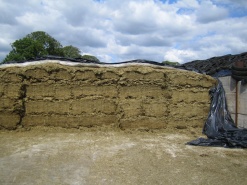 There is another reason why the top metre
is often less stable. Most pits are not fully airtight. Black plastic sheets and cling film are porous
to air and can let more than 2 litres of air through each square metre every day especially outdoors
on windy sites where the air pressure is constantly changing.
There is another reason why the top metre
is often less stable. Most pits are not fully airtight. Black plastic sheets and cling film are porous
to air and can let more than 2 litres of air through each square metre every day especially outdoors
on windy sites where the air pressure is constantly changing.
In addition it is common to see poor seals at the edges of the pit, at the foot of the ramp and common to find pin holes in sheets due to bird and animal damage.
Air can easily penetrate down into the pit more than a metre and several metres across if dry matters are above 28% and consolidation is not as good as it gets. Always use a genuine low transmission oxygen barrier sheet such as Passion Yellow or Silostop Orange, and a protective net. Make sure the clamp really is airtight. It also helps to have some weight on top of the net. Good face management, block cutters, defacers definitely help as does keeping the area around the front of the pit clean to reduce the amount of mould spores contaminating the face.
Having sorted out the management issues then yes, the Ultra-Sile range has some excellent products which have proved very effective on farm in reducing or eliminating spoilage, moulding and heating issues at feed out. Products such as Ultra-Sile Dry and Ultra-Sile Arable are very effective at minimising heating at the silage face provided that normal silage management is fully observed.
 Ultra-Sile products are continually updated to take full advantage of the very latest technological advances. Ultra-Sile Dry, Ultra-Sile HiDri and Ultra-Sile Maize include a very advanced new strain of bacteria, Lactobacillus casei which is not only a very fast fermenter but is also very effective at removing oxygen from the clamp during the first few hours of the fermentation. Fermentation to acidify the clamp is an anaerobic process which cannot start until oxygen levels are reduced.
Ultra-Sile products are continually updated to take full advantage of the very latest technological advances. Ultra-Sile Dry, Ultra-Sile HiDri and Ultra-Sile Maize include a very advanced new strain of bacteria, Lactobacillus casei which is not only a very fast fermenter but is also very effective at removing oxygen from the clamp during the first few hours of the fermentation. Fermentation to acidify the clamp is an anaerobic process which cannot start until oxygen levels are reduced.
The effect of using inoculant bacteria strains which are capable of speeding up this process not only speeds up the whole fermentation process reducing dry matter and energy losses and reducing protein breakdown but also inhibits the growth of spoilage organisms, yeasts and moulds. These advanced inoculants use the very latest technology and show clear advantages over many other inoculants in terms of fermentation efficiency, intake characteristics, levels of toxins, nutritional quality of the silage and face stability.
42. Will Ultra-Sile prevent top and shoulder waste?
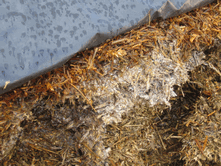 The principle causes of top and shoulder
waste are due to air being present in the silage during the start of the fermentation. This is due to
a lack of consolidation, particularly with dry, long chopped, mature, stalky forages, over-filled clamps,
a lack of rolling and inadequate sheeting and sealing systems.
The principle causes of top and shoulder
waste are due to air being present in the silage during the start of the fermentation. This is due to
a lack of consolidation, particularly with dry, long chopped, mature, stalky forages, over-filled clamps,
a lack of rolling and inadequate sheeting and sealing systems.
When air is present then an anaerobic silage fermentation cannot start and acidification of the top layers is delayed but crop respiration continues, temperature rises and spoilage organisms multiply rapidly. Energy, protein and dry matter are rapidly lost and the top layers behave like a compost heap. It must be remembered that silage additive are not a replacement for good management practices. A silage additive may help but will not compensate for inadequate sealing.
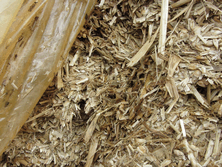 Firstly, where possible use lower dry matter, less mature forages on top of the clamp. Chop the top
1 or 2 metres as short as possible and pay attention to rolling thin layers. If possible use an additional
tractor, the heavier the better and with narrow tyres to aid consolidation. It is impossible to roll
shoulders, so never over fill the clamp and never have any slopes of greater than 30o. If
the clamp is full put the rest of the crop in a separate roll over pit if no other clamps are available.
Plan ahead where crops are bigger than expected. Always side sheet and sheet as soon as the clamp is
full.
Firstly, where possible use lower dry matter, less mature forages on top of the clamp. Chop the top
1 or 2 metres as short as possible and pay attention to rolling thin layers. If possible use an additional
tractor, the heavier the better and with narrow tyres to aid consolidation. It is impossible to roll
shoulders, so never over fill the clamp and never have any slopes of greater than 30o. If
the clamp is full put the rest of the crop in a separate roll over pit if no other clamps are available.
Plan ahead where crops are bigger than expected. Always side sheet and sheet as soon as the clamp is
full.
Always use a genuine low transmission oxygen barrier film rather than cling film to seal the clamp. An additional black sheet and protective net will prevent damage to the film. Applying an even weight over the entire net to remove air pockets and to further consolidate the top layers is highly beneficial. Attention to detail in making sure that all seams and edges really are air tight is essential.
It is common practice on farms to be able to see exposed silage sticking out from under sheets. This will invariably result in waste and air can travel horizontally through the top layers of silage for several metres.
 With well consolidated silage in a fully air tight clamp then yes, a silage additive
which produces a rapid drop in pH will reduce the amount of spoilage organisms present in the finished
silage. Better still a multi-strain silage additive containing hetero-fermentative bacterial strains which will produce acetic, propionic and other acids rather than
lactic acid alone will make a big difference to stability.
With well consolidated silage in a fully air tight clamp then yes, a silage additive
which produces a rapid drop in pH will reduce the amount of spoilage organisms present in the finished
silage. Better still a multi-strain silage additive containing hetero-fermentative bacterial strains which will produce acetic, propionic and other acids rather than
lactic acid alone will make a big difference to stability.
When silages heat at or behind the face at
feed out, usually on the top third of the pit and usually on drier less well consolidated silages, lactic
acid is rapidly broken down by lactate assimilating yeasts whereas acetic acid is not.
Ultra-Sile Silage Range is particularly well suited to
reducing silage face heating and top waste
43. Will Ultra-Sile cope with wet, low sugar grass silage?
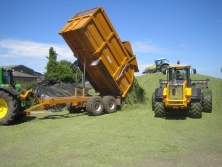 Ultra-Sile
Rapid would be our product of choice to cope with wet low sugar grass silage harvested in difficult ensiling
conditions. This high specification product based on multi-strain homo-fermentative lactic acid producing bacteria,
we believe is one of the fastest and most efficient fermenters on the market.
Ultra-Sile
Rapid would be our product of choice to cope with wet low sugar grass silage harvested in difficult ensiling
conditions. This high specification product based on multi-strain homo-fermentative lactic acid producing bacteria,
we believe is one of the fastest and most efficient fermenters on the market.
Having seen numerous extreme situations where it has coped admirably we are convinced that it will outperform most other silage additives in challenging situations.
In wet silages due to the high water content a lot of acid is required for full stability. This means there will be higher fermentation losses than on a drier silage due to the extent of the fermentation. Ultra-Sile Rapid minimises these losses by encouraging a fast, cool homo-lactic fermentation, typically around 2 days rather than up to six weeks on an untreated silage.
 Ultra-Sile Rapid uses sugars very efficiently which is important since more sugar is required to produce
the additional acid required in wet conditions. In addition Lactobacillus paracasei has the ability produce
fructanase enzyme to convert fructans into soluble fructose sugars if required. These additional sugars
are available to the bacteria to complete the fermentation. Lactobacillus paracasei is also very effective at suppressing clostridia which are the main cause of butyric silage. This approach is more effective than adding enzymes
directly as excess enzymes can lead to loss of dry matter, aerobic instability, heating and growth of moulds on the silage.
Ultra-Sile Rapid uses sugars very efficiently which is important since more sugar is required to produce
the additional acid required in wet conditions. In addition Lactobacillus paracasei has the ability produce
fructanase enzyme to convert fructans into soluble fructose sugars if required. These additional sugars
are available to the bacteria to complete the fermentation. Lactobacillus paracasei is also very effective at suppressing clostridia which are the main cause of butyric silage. This approach is more effective than adding enzymes
directly as excess enzymes can lead to loss of dry matter, aerobic instability, heating and growth of moulds on the silage.
Ultra-Sile silage additives used to treat very wet low sugar, grass silages have consistently produced excellent fermentation characteristics
Nobody sets out to make very wet silage and often when the weather breaks with no notice whatever silage additive is available on farm is used. Encouragingly due to the very high specifications of Ultra-Sile inoculants we have seen numerous examples of very wet silages, 15% - 19% DM having been treated with products within the Ultra-Sile range which have shown excellent fermentation characteristics. Trial data has also confirmed that Ultra-Sile Dry and Ultra-Sile Arable which are designed for higher dry matter crops, can produce excellent results comparable to Ultra-Sile Rapid on very dirty, November cut grass silage at 15% DM. Back to top
44. Do I need to mix Ultra-Sile silage additives the day before?
There is no advantage to mixing the day before. Ideally mix 1-2 hours before harvesting or mix and use straight away once the contractor has arrived. Back to top
45. What is the application rate for Ultra-Sile silage additive?
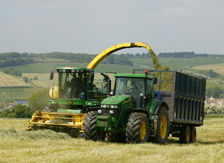 Ultra-Sile
inoculants can be applied at anywhere between 0.2 litres and 2 litres per tonne of forage. Our preference
is for 0.25 - 1 litre per tonne depending on the applicator and forage harvester.
Ultra-Sile
inoculants can be applied at anywhere between 0.2 litres and 2 litres per tonne of forage. Our preference
is for 0.25 - 1 litre per tonne depending on the applicator and forage harvester.
The aim should be to mix the additive at the start of the day and run right through or top up once in the afternoon. A 400 litre tank applied at 0.5 litres / tonne will treat 800 tonnes of forage on one mixing or 1600 tonnes at 0.25 litres per tonne. Enough for a days work with a self-propelled harvester on most farms.
ULV additives are applied at 10ml to 120ml per tonne depending on the applicator.
Granular additives are applied dry at either 0.2 or 0.4 kg per tonne of forage depending on the product.
Dual-Action and Liquid Combined Inoculant Preservative products will depend on individual situations. Back to top
46. How long will Ultra-Sile silage additives last once mixed?
Best practice would be to mix on the morning of use and use within 12 hours. Having said that, trials have shown that a high percentage of live bacteria are still viable after seven days. However after several days mixed, the pH will be low and some sedimentation may occur, fresh material should not be added to the partially fermented mixed additive and care should be taken to check and clean applicator filters regularly. Wash out applicator tanks, pipes and pumps daily. Back to top
47. My contractor prefers Ultra Low Volume ULV additives?
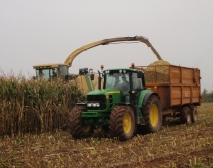 Silage
inoculants were traditionally applied at 2 litres per tonne. This was a throwback
to the days of applying acids at 2 or 5 litres per tonne or 'brew your own' products applied at 2 litres.
Silage
inoculants were traditionally applied at 2 litres per tonne. This was a throwback
to the days of applying acids at 2 or 5 litres per tonne or 'brew your own' products applied at 2 litres.
Today most conventional applicators are set up to handle lower additive application rates of 250ml to 1 litre. Applying 250ml per tonne provides sufficient additive from one 400 litre tank of additive for 1600 tonnes of silage which is more than a days work on a self propelled forage harvester.
ULV (Ultra Low Volume) application was introduced to the UK principally for commercial reasons in an attempt by some additive manufacturers to tie contractors into using only their products. Contractors were supplied with a ULV applicator which could often only handle that manufacturer's additive. ULV applicators generally apply between 10ml and 80ml of liquid additive per tonne of forage.
ULV application with reduced volumes of water may be more convenient, but in our view, increasing the application rate to between 250ml and 1 litre per tonne of forage is likely to produce the best silage. Conventional rates of application apply a spray with very few losses, whereas applying 10ml of additive per tonne of forage as a mist does open up the possibility of losses to the atmosphere.
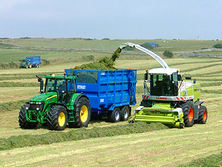 Conventional
additives designed for higher volume application rates generally carry nutrients so that the inoculant
bacteria can begin multiply immediately after mixing. Whereas ULV additives are generally designed to multiply only after application.
Conventional
additives designed for higher volume application rates generally carry nutrients so that the inoculant
bacteria can begin multiply immediately after mixing. Whereas ULV additives are generally designed to multiply only after application.
Consequently conventional application can provide greater numbers of more active bacteria for a faster fermentation.
Shelf life of the product once mixed is generally much longer with conventional additive application due to the levels of nutrients provided and higher dilution rates used. At higher dilution rates there is less risk of potential damage to the inoculant bacteria from high osmotic pressures, high acid levels or from large pressure drops when applying very fine sprays under pressure.
In our view standard application at 250ml - 1 litre per tonne through a conventional applicator has advantages over ULV in terms of silage quality. A comprehensive range of good quality silage additive applicators are available from Selmech Supplies.
Ultra-Sile standard additives can be successfully applied at as little as 80ml per tonne of forage through some ULV applicators. Alternatively where there is a preference for using a ULV applicator, all Ultra-Sile biological additives can be supplied as ULV formulations suitable for applications at rates as low as 10ml per tonne of forage. Back to top
48. Do Ultra-Sile Additives come in ULV and Granular options?
Ultra-Sile inoculants are normally supplied in sachets for mixing with water and treat 50 or 100 tonnes of
forage. This is the preferred option. Usually liquid application rates are at between 250ml and 1 litre per tonne
of forage but can go down to lower rates.
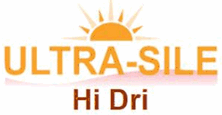
Ultra-Sile additives are available in ULV (Ultra Low Volume) and Granular forms. Ultra-Sile ULV additives are supplied in either sachets or in bottles and are designed to mix with water and apply at between 10ml and 100ml per tonne of forage.
Granular additives are in 20kg bags and are applied dry using a granular applicator.
49. Will Ultra-Sile Additives help us reach net zero carbon emissions?
Ultra-Sile inoculants are one of many tools which not only increase profitability but also help to reduce losses and increase output making dairy and livestock farms more efficient.
Effectively since dry matter losses are reduced during fermentation and more nutrients are retained there is more silage to feed. Silage will also have a higher feed value. This means higher milk yields in dairy cows or increased live weight gains in growing cattle whilst fewer concentrate inputs can be used.
Methane emissions per unit of output are lower on higher yielding animals. Fewer acres are needed to feed the animals which means less fertiliser used and lower machinery costs. This results in fewer emissions and lower carbon footprint.
50. Are Ultra-Sile silage additives suitable for organic use?
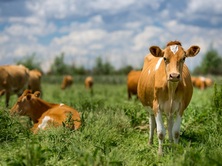 Yes: All Ultra-Sile biological products are suitable for use in organic systems. Ultra-sile inoculants are based on specially selected strains of naturally occurring bacteria. The are fully compliant with the ethos of organic systems.
Yes: All Ultra-Sile biological products are suitable for use in organic systems. Ultra-sile inoculants are based on specially selected strains of naturally occurring bacteria. The are fully compliant with the ethos of organic systems.
Organic farms do not have access to chemical fertilisers and are heavily weighted towards forage based systems. Purchased organic concentrates are more costly than conventional concentrates and the level of concentrate which can fed is limited. It is therefore extremely important to maximise forage quality. Inoculants reduce dry matter losses and nutrient losses during the fermentation. Consequently there is more silage to feed and with a higher feed value.
Use of silage additives in organic systems allow higher animal performance on less concentrates. Effectively this means that both emissions and carbon footprint are reduced. Return on investment is even greater on organic than on conventional systems and additives really are fully compatible with organic farming.
51. How quickly can Ultra-Sile additives be delivered?
 Generally we can deliver product next
day if we have it in stock and receive the order before 10:00 am. It is best to allow 2 weeks lead time
at busy times or better still let us know your requirements for the whole season at the start of
the year or before.
Generally we can deliver product next
day if we have it in stock and receive the order before 10:00 am. It is best to allow 2 weeks lead time
at busy times or better still let us know your requirements for the whole season at the start of
the year or before.
Order quantities can always be adjusted during the season but these products contain live bacteria and production needs to be planned months ahead of delivery times.
If the majority of users order in advance it does help to keep costs down. Back to top
52. Should I take advantage of early order?
A high percentage of our customers place orders between November and January for the coming season. This enables us to to plan ahead making long runs of product well ahead of time keeping our costs to a minimum. This makes Ultra-Sile very competitive in the UK market place. Back to top
53. How do I place an order?
To place an order contact Richard Webster who will be able to advise on choice of additive and provide advice on making better silage.
 You
might also like to check out the following pages:
You
might also like to check out the following pages:
Lorry Tyre Sidewalls, Gravel
Bags, Oxygen Barrier Films,
Protective
Silage Net and Covers, Silage Additives and Inoculants, Financial Benefits of using Silage Additive
Alternatively download the Ultra-Sile Silage Additive UK Leaflet
Ultra-Sile Silage Additives offer clear economic benefits to the farmer
Silage additives have been shown to improve silage quality and animal performance but are not replacements for good management practices. Back to top
